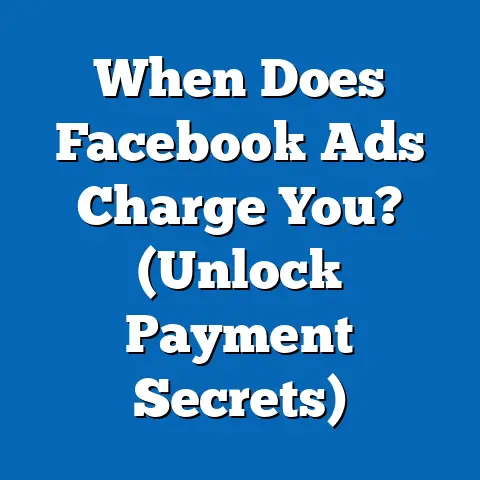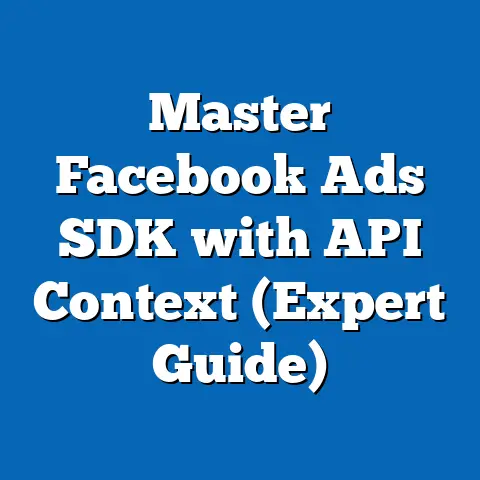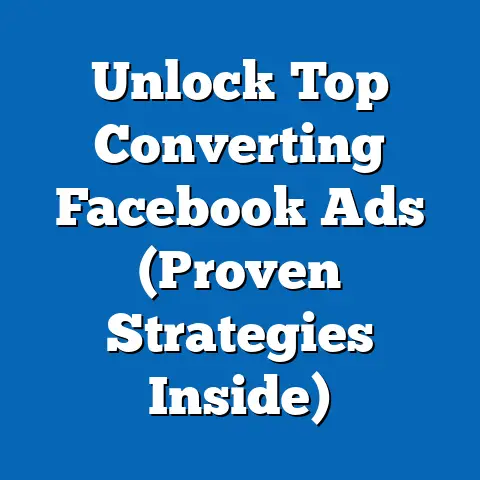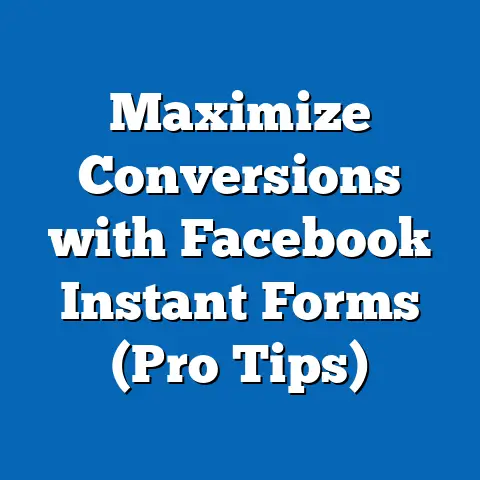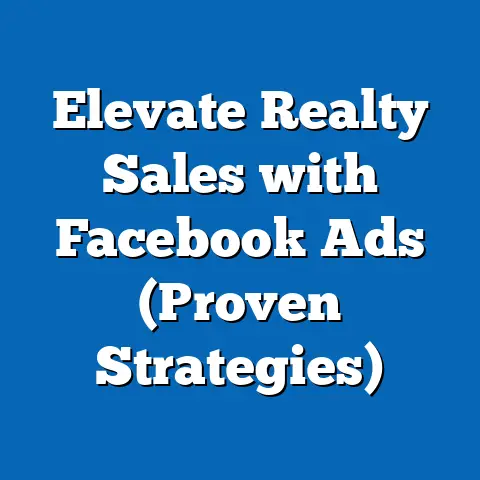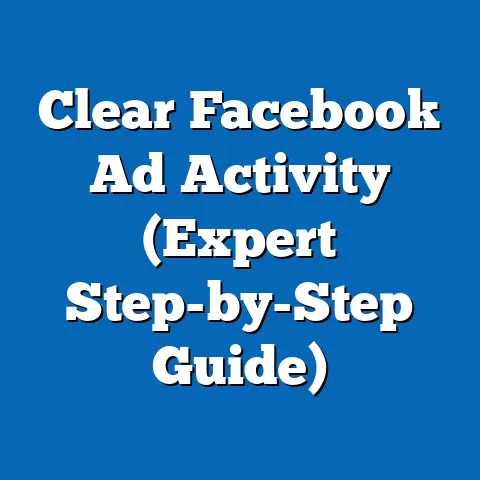Master Facebook Mobile Video Ad Size (Essential Guide)
The world is glued to its smartphones. Think about it: how many times a day do you reach for your phone? I know I check mine constantly, whether it’s for emails, social media, or just killing time. And I’m not alone. Mobile devices have become the primary way people consume content, and that includes advertising. But simply throwing any old video ad onto Facebook isn’t going to cut it. You need to understand the nuances of mobile viewing, especially when it comes to video ad size. That’s where this guide comes in.
Imagine your brand’s message as a delicate electronic device. Now imagine that device being subjected to the unpredictable elements of the digital world: fluctuating internet speeds, diverse screen sizes, and the ever-fickle attention spans of mobile users. Just like a smartphone needs a waterproof case to survive a sudden downpour, your video ads need to be meticulously optimized to withstand the challenges of mobile viewing.
Think of it this way: “waterproofing” your video ad isn’t about making it impervious to water, but about ensuring its resilience and adaptability. It’s about creating content that loads quickly, looks great on any screen, and grabs attention instantly, no matter the circumstances. A poorly optimized video, on the other hand, is like taking your phone for a swim without protection – a recipe for disaster.
In this guide, I’ll walk you through everything you need to know to create Facebook mobile video ads that are not only visually appealing but also technically sound. We’ll dive into the specifics of video ad sizes, aspect ratios, file formats, and more. I’ll share best practices for creating engaging content and provide a list of tools that can help you streamline the video creation process. By the end of this guide, you’ll have the knowledge and resources to create mobile video ads that truly shine, driving engagement, conversions, and ultimately, business growth.
Understanding Facebook Mobile Video Ads
Facebook mobile video ads are video advertisements specifically designed to be viewed on smartphones and tablets. They appear in various locations within the Facebook mobile app and website, including the news feed, stories, in-stream videos, and even within Messenger. These ads are a powerful tool for reaching a massive audience, given Facebook’s enormous user base and the increasing popularity of video content.
From my own experience, I’ve seen firsthand how video ads can outperform static images or text-based ads. People are naturally drawn to moving images, and a well-crafted video can quickly convey a brand’s message, showcase a product, or tell a compelling story.
Why Mobile Matters
The key word here is “mobile.” According to Statista, mobile devices account for a significant percentage of Facebook’s ad revenue. People are spending more and more time on their phones, scrolling through their feeds, watching videos, and interacting with content. This makes mobile advertising an essential component of any modern marketing strategy.
Here’s why understanding user behavior on mobile devices is crucial for video ad success:
- Shorter Attention Spans: Mobile users are often on the go, multitasking, and easily distracted. This means you have a very limited window to capture their attention.
- Sound Off: Many people watch videos on their phones with the sound off, either because they’re in a public place or simply prefer to browse silently.
- Vertical Viewing: Mobile screens are typically held vertically, so videos optimized for vertical viewing tend to perform better.
- Data Considerations: Mobile users may be concerned about data usage, so it’s important to keep video file sizes as small as possible without sacrificing quality.
Video vs. Static Ads: A Clear Winner
While static image ads can still be effective, video ads offer several distinct advantages:
- Higher Engagement: Videos are more engaging than static images and can capture attention more effectively.
- Better Storytelling: Videos allow you to tell a more complete and compelling story, showcasing your brand’s personality and values.
- Increased Brand Recall: Viewers are more likely to remember a brand after watching a video ad.
- Higher Conversion Rates: When done right, video ads can lead to higher click-through rates and conversion rates.
I remember working on a campaign for a local restaurant that was struggling to attract new customers. We initially ran static image ads showcasing their menu items, but the results were underwhelming. Then, we decided to create a short video featuring the chef preparing one of their signature dishes. The video was mouthwatering, visually appealing, and told a story about the restaurant’s commitment to quality. The results were dramatic. The video ad generated significantly more engagement, traffic to the restaurant’s website, and ultimately, a noticeable increase in sales.
Key Takeaway: Facebook mobile video ads are a powerful tool for reaching a large audience and driving engagement. Understanding mobile user behavior and leveraging the advantages of video over static ads is crucial for success.
Importance of Video Ad Size
So, you understand the power of Facebook mobile video ads, but why should you care about the size of your video? Well, it’s not just about how big it looks on the screen (although that’s a factor). Video ad size, in the digital world, refers to the file size of the video, measured in megabytes (MB). It also refers to the dimensions of the video, measured in pixels. Both these aspects of size play a critical role in the performance of your ads.
The Speed Factor: Loading Times and User Experience
Imagine you’re scrolling through your Facebook feed and come across a video ad that looks interesting. You tap on it, but instead of playing instantly, it takes ages to load. Frustrating, right? Most people won’t wait around for a slow-loading video. They’ll simply scroll on, and you’ve lost their attention.
Video ad size directly impacts loading times. Large video files take longer to download, especially on mobile networks with limited bandwidth. This can lead to a poor user experience, causing viewers to abandon your ad before it even starts playing.
I’ve seen this happen countless times. A client will create a stunning video ad, packed with high-resolution visuals and impressive effects, only to find that it performs poorly. The problem? The video file is too large, causing slow loading times and high bounce rates.
The Data Drain: Mobile Data Usage
Mobile users are often mindful of their data usage, especially if they have limited data plans. A large video ad can quickly eat into their data allowance, leading to frustration and resentment towards your brand.
Facebook tries to mitigate this by automatically adjusting video quality based on the user’s connection speed. However, even with automatic optimization, a smaller video file will always be more data-friendly.
The Performance Impact: Metrics That Matter
Optimized video sizes can significantly impact your ad metrics, including:
- Click-Through Rate (CTR): Faster loading times and a better user experience can lead to higher click-through rates.
- Engagement Rate: Viewers are more likely to engage with a video that loads quickly and plays smoothly.
- Video Completion Rate: People are more likely to watch a video to the end if it doesn’t buffer or lag.
- Conversion Rate: Ultimately, optimized video sizes can contribute to higher conversion rates and a better return on investment (ROI).
Case Study:
I once worked with an e-commerce client that was running Facebook video ads to promote their new line of clothing. Their initial video ads were visually appealing but had large file sizes, averaging around 50MB. After analyzing their ad performance, we noticed a high bounce rate and low video completion rate.
We decided to optimize the video ads by reducing the file size without compromising visual quality. We compressed the videos, optimized the resolution, and trimmed unnecessary footage. The resulting video ads were significantly smaller, averaging around 15MB.
The results were remarkable. The optimized video ads saw a 30% increase in click-through rate, a 20% increase in video completion rate, and a 15% increase in conversion rate. This demonstrates the tangible impact that optimized video sizes can have on ad performance.
Key Takeaway: Video ad size is a critical factor in mobile advertising success. Optimizing video sizes can improve loading times, enhance user experience, reduce data usage, and ultimately, drive better ad performance.
Specifications for Facebook Mobile Video Ads
Now let’s get down to the nitty-gritty: the specific technical requirements for Facebook mobile video ads. Facebook has a comprehensive set of guidelines that you need to adhere to in order to ensure your ads are displayed correctly and perform optimally.
These specifications cover various aspects of video ads, including:
- Aspect Ratio
- Video Length
- File Format and Size Limits
- Resolution
- Frame Rate
- Audio Requirements
Aspect Ratio: The Shape of Your Video
Aspect ratio refers to the ratio of a video’s width to its height. Choosing the right aspect ratio is crucial for ensuring your video looks good on different mobile devices and in various ad placements.
Here are the recommended aspect ratios for Facebook mobile video ads:
- 1:1 (Square): Ideal for news feed ads and Instagram. This aspect ratio is visually appealing and takes up a good amount of screen real estate.
- 4:5 (Vertical): Another great option for news feed ads, especially on mobile. This aspect ratio is slightly taller than square and can capture more attention.
- 9:16 (Full Vertical): Perfect for Facebook and Instagram Stories. This aspect ratio takes up the entire screen, creating an immersive viewing experience.
- 16:9 (Landscape): Suitable for in-stream video ads and other placements where a wider format is preferred.
I always advise clients to create multiple versions of their video ads in different aspect ratios to maximize their reach and impact. For example, you could create a 1:1 version for the news feed and a 9:16 version for Stories.
Video Length: Keeping It Concise
In the age of short attention spans, video length is a crucial consideration. Facebook recommends keeping your video ads concise and to the point.
Here are the ideal video lengths for different ad placements:
- News Feed: 15 seconds or less.
- Stories: 15 seconds or less per card.
- In-Stream Videos: 15-30 seconds.
While you can technically upload longer videos, it’s generally best to keep them short and sweet. Focus on conveying your message quickly and effectively.
I’ve found that the first few seconds of your video are the most critical. If you don’t grab viewers’ attention within the first 3 seconds, they’re likely to scroll on.
File Format and Size Limits: Keeping It Lean
Facebook supports a variety of video file formats, including:
- MP4
- MOV
- AVI
MP4 is generally the preferred format, as it offers a good balance of quality and file size.
The maximum file size for Facebook video ads is 4GB, but I recommend keeping your videos much smaller than that, ideally under 100MB. Smaller file sizes lead to faster loading times and a better user experience.
Resolution: Striking a Balance
Resolution refers to the number of pixels in a video image. Higher resolution videos look sharper and more detailed, but they also have larger file sizes.
For Facebook mobile video ads, I recommend using a resolution of at least 1080p (1920×1080 pixels) for optimal quality. However, you can also use lower resolutions like 720p (1280×720 pixels) if you need to reduce file size.
Frame Rate: Smooth Motion
Frame rate refers to the number of frames displayed per second in a video. A higher frame rate results in smoother motion, but it also increases file size.
For Facebook mobile video ads, a frame rate of 30 frames per second (fps) is generally recommended. This provides a good balance of smoothness and file size.
Audio Requirements: Sound Advice
While many people watch videos with the sound off, it’s still important to include high-quality audio in your video ads.
Facebook recommends using a stereo audio track with a sample rate of 44.1 kHz. Make sure your audio is clear, well-mixed, and doesn’t contain any distracting background noise.
Ensuring Video Quality While Adhering to Specifications:
Adhering to these specifications is crucial, but it’s also important to maintain video quality. Here are some tips:
- Use High-Quality Source Footage: Start with the best possible source footage to ensure a good end result.
- Optimize Compression Settings: Experiment with different compression settings to find the right balance between file size and quality.
- Avoid Over-Editing: Excessive editing and effects can degrade video quality.
- Preview Your Videos: Always preview your videos on different devices and in different ad placements to ensure they look good.
Key Takeaway: Understanding and adhering to Facebook’s video ad specifications is essential for creating effective mobile video ads. Pay attention to aspect ratio, video length, file format, resolution, frame rate, and audio requirements to ensure your videos look great and perform optimally.
Best Practices for Creating Effective Mobile Video Ads
Technical specifications are important, but they’re only half the battle. To create truly effective Facebook mobile video ads, you also need to focus on creative strategies that engage viewers and drive results.
Here are some best practices to keep in mind:
Grab Attention in the First Few Seconds:
As I mentioned earlier, the first few seconds of your video are crucial. You need to capture viewers’ attention quickly and make them want to keep watching.
Here are some techniques for grabbing attention:
- Start with a Hook: Use a compelling visual, question, or statement to pique viewers’ curiosity.
- Showcase Your Brand Immediately: Don’t wait until the end of the video to introduce your brand.
- Use Bright Colors and Eye-Catching Visuals: Make your video visually appealing and stand out in the feed.
- Highlight the Problem and Solution: Quickly identify a problem that your target audience faces and show how your product or service solves it.
Mobile-Friendly Visuals: Big and Bold
Mobile screens are small, so it’s important to use visuals that are easy to see and understand.
Here are some tips for creating mobile-friendly visuals:
- Use Large Text: Make sure your text is large enough to be easily read on a small screen.
- Use High-Contrast Colors: Choose colors that contrast well with each other to improve readability.
- Focus on Key Visual Elements: Don’t clutter your video with too many details.
- Use Close-Ups: Show products and features in close-up to highlight their details.
Captions and Subtitles: Sound Optional
As I mentioned earlier, many people watch videos on their phones with the sound off. This means that captions and subtitles are essential for conveying your message.
Here are some tips for using captions and subtitles:
- Include Captions for All Spoken Content: Make sure your captions accurately reflect what is being said in the video.
- Keep Captions Concise and Easy to Read: Use short, simple sentences and avoid jargon.
- Use a Clear and Readable Font: Choose a font that is easy to read on a small screen.
- Position Captions Strategically: Place captions where they won’t cover up important visual elements.
Examples of Successful Mobile Video Ads:
Let’s take a look at some examples of successful mobile video ads and analyze what makes them effective:
-
Dollar Shave Club: Dollar Shave Club is known for its humorous and irreverent video ads. Their mobile video ads are short, funny, and effectively showcase their product and brand personality. They understand their target audience and create content that resonates with them.
-
Airbnb: Airbnb’s mobile video ads often feature real people sharing their travel experiences. These ads are authentic, emotionally engaging, and showcase the benefits of using Airbnb. They tell a story and connect with viewers on a personal level.
-
Nike: Nike’s mobile video ads are visually stunning and feature athletes pushing their limits. These ads are inspirational, motivational, and showcase Nike’s brand values. They use high-quality visuals and powerful storytelling to create a memorable impact.
Dollar Shave Club: Dollar Shave Club is known for its humorous and irreverent video ads. Their mobile video ads are short, funny, and effectively showcase their product and brand personality. They understand their target audience and create content that resonates with them.
Airbnb: Airbnb’s mobile video ads often feature real people sharing their travel experiences. These ads are authentic, emotionally engaging, and showcase the benefits of using Airbnb. They tell a story and connect with viewers on a personal level.
Nike: Nike’s mobile video ads are visually stunning and feature athletes pushing their limits. These ads are inspirational, motivational, and showcase Nike’s brand values. They use high-quality visuals and powerful storytelling to create a memorable impact.
Analyzing the Components:
What do these successful mobile video ads have in common?
- Clear Message: They all have a clear and concise message that is easy to understand.
- Engaging Visuals: They use visually appealing and eye-catching visuals to capture attention.
- Strong Call to Action: They include a clear call to action that tells viewers what to do next.
- Targeted Audience: They are targeted to a specific audience and resonate with their interests and needs.
Key Takeaway: Creating effective Facebook mobile video ads requires a combination of technical expertise and creative strategy. Focus on grabbing attention quickly, using mobile-friendly visuals, including captions and subtitles, and creating content that resonates with your target audience.
Tools and Resources for Video Ad Creation
Creating compelling Facebook mobile video ads doesn’t have to be expensive or complicated. There are a variety of tools and resources available that can help you streamline the video creation process, regardless of your budget or skill level.
Video Editing Software:
-
Adobe Premiere Rush: A user-friendly video editing app for mobile and desktop. It offers a range of features, including motion graphics templates, audio tools, and color correction. (Paid)
-
iMovie: A free video editing app available on iOS devices. It’s easy to use and offers a range of basic editing features. (Free)
-
Canva: While primarily a graphic design tool, Canva also offers video editing capabilities. It’s a great option for creating simple video ads with text overlays and graphics. (Free and Paid Options)
Adobe Premiere Rush: A user-friendly video editing app for mobile and desktop. It offers a range of features, including motion graphics templates, audio tools, and color correction. (Paid)
iMovie: A free video editing app available on iOS devices. It’s easy to use and offers a range of basic editing features. (Free)
Canva: While primarily a graphic design tool, Canva also offers video editing capabilities. It’s a great option for creating simple video ads with text overlays and graphics. (Free and Paid Options)
Stock Footage and Music:
-
Pexels: A website that offers a wide variety of free stock photos and videos.
-
Pixabay: Another great source for free stock photos and videos.
-
Epidemic Sound: A subscription-based service that offers a library of high-quality music and sound effects. (Paid)
Pexels: A website that offers a wide variety of free stock photos and videos.
Pixabay: Another great source for free stock photos and videos.
Epidemic Sound: A subscription-based service that offers a library of high-quality music and sound effects. (Paid)
A/B Testing Platforms:
-
Facebook Ads Manager: Facebook’s built-in A/B testing tool allows you to test different versions of your video ads to see which performs best.
-
VWO: A website optimization platform that offers A/B testing and personalization features. (Paid)
Facebook Ads Manager: Facebook’s built-in A/B testing tool allows you to test different versions of your video ads to see which performs best.
VWO: A website optimization platform that offers A/B testing and personalization features. (Paid)
My Personal Recommendations
From my experience, I’ve found that a combination of tools works best. I often use Adobe Premiere Pro for more complex video editing projects, but I also rely on Canva for creating quick and simple video ads with text overlays and graphics. For stock footage and music, I often turn to Pexels and Epidemic Sound.
Key Takeaway: There are a variety of tools and resources available to help you create Facebook mobile video ads. Explore different options and find the ones that best suit your needs and budget.
Analyzing and Measuring Success
You’ve created your Facebook mobile video ads, but how do you know if they’re actually working? That’s where analytics and measurement come in. Tracking the performance of your video ads is essential for understanding what’s working, what’s not, and how to improve your campaigns over time.
Facebook Insights and Ads Manager:
Facebook provides a wealth of data about your video ad performance through Facebook Insights and Ads Manager. These tools allow you to track a variety of metrics, including:
- Reach: The number of people who saw your ad.
- Impressions: The number of times your ad was displayed.
- Video Views: The number of times your video was watched for at least 3 seconds.
- Video Completion Rate: The percentage of people who watched your video to the end.
- Engagement: The number of likes, comments, and shares your video received.
- Click-Through Rate (CTR): The percentage of people who clicked on your ad.
- Conversion Rate: The percentage of people who took a desired action after seeing your ad (e.g., making a purchase, signing up for a newsletter).
- Cost Per Result: The average cost of achieving a desired result (e.g., cost per video view, cost per conversion).
Key Performance Indicators (KPIs):
Which metrics should you focus on? It depends on your campaign goals, but here are some key performance indicators (KPIs) to monitor:
- Brand Awareness: Reach, impressions, and video views.
- Engagement: Engagement rate, video completion rate, and shares.
- Website Traffic: Click-through rate.
- Conversions: Conversion rate and cost per result.
Interpreting the Data:
Once you’ve collected data on your video ad performance, it’s time to interpret it and use it to refine your campaigns.
Here are some questions to ask yourself:
- Is my reach broad enough? If not, consider expanding your targeting or increasing your budget.
- Are people engaging with my video? If not, consider improving your creative or targeting a more relevant audience.
- Are people clicking on my ad? If not, consider improving your call to action or making your ad more relevant to their target audience.
- Are people converting after seeing my ad? If not, consider improving your landing page or making your offer more compelling.
Key Takeaway: Analyzing and measuring the performance of your Facebook mobile video ads is essential for understanding what’s working, what’s not, and how to improve your campaigns over time. Use Facebook Insights and Ads Manager to track key metrics and interpret the data to refine your strategies.
Conclusion
Mastering Facebook mobile video ad size is more than just a technical exercise; it’s a strategic imperative for anyone looking to thrive in today’s mobile-first world. As I’ve shared, the nuances of aspect ratio, video length, file format, and more, all play a crucial role in determining whether your message breaks through the noise or gets lost in the shuffle.
Remember that analogy about waterproofing your device? Just as a protective case shields your phone from the elements, a well-optimized video ad safeguards your brand’s message, ensuring it resonates with viewers, loads quickly, and delivers a seamless experience, regardless of their device or connection speed.
So, take the guidelines I’ve provided, experiment with different formats, and don’t be afraid to get creative. The world of mobile video advertising is constantly evolving, so it’s important to stay curious, adaptable, and always be willing to learn.
And finally, remember that mobile video ads are not just about driving sales; they’re about building relationships, fostering brand loyalty, and creating a lasting connection with your audience. By mastering the art of mobile video advertising, you can unlock the full potential of Facebook as a powerful marketing platform, driving business growth and achieving your marketing goals.

